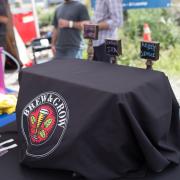I am going to start venturing into all grain and decided I needed to get a bit more serious about my recipes so I grabbed BeerSmith 2. I started with watching the video about setting up the equipment profile and walked through it, but I am left a little perplexed and confused. As I do my best shot at setting up my profile I am confused why it is saying my boil volume for my supposed 5.0G batch should only be 6.22G, yet in my experience with my brews on the CHAOS equipment so far I have used 7G. I realize of course it is going to depend on how aggressive my boil is for the amount lost, and I'm still getting used to setting the burner just so.
For other aspects I set the mash tun size to 10 gallon because that is what I believe we have on site, and I googled and found the weight of those being 9lbs. Deadspace I went with .3 gallons based off of another thread in the forums from back in 2013. That thread had some good info, however there also appeared to be a fair amount of frustration as well.... then it turned to efficiency and I was lost :)
Anyhow, I understand it is going to be hit and miss when using this software, everything is. I just want to set up the EQ profile as best I can to start with and I'm looking for comments/suggestions. Hopefully this image gets added properly to show the profile.
Was going to attach the exported profile but the forum doesn't accept that file format.
TIA
Bill










If you are wanting 5 gallons of finished, packaged beer at the end of the process, set your finished boil volume to 6 gallons. That will most likely put your pre-boil volume around the 7-7.5 gallon mark.
Then, when all is said and done, I factor a 5.5 gallon transfer to my fermentor (leaving behind the 0.5 gallons of kettle sludge). The beer ferments out, and I can again transfer 5 even gallons to packaging, leaving behind the other 0.5 gallons of fermentor trub.
I'm on my chromebook now, so no access to my BS2 profiles, but hopefully I'll have a chance to look at what I have entered later today.
The mashtuns are 10 gallons, I don't think I have worried about their weight. Your deadspace sounds like it's in the ballpark. There's also another ~half gallon deadspace in our chiller. So maybe even an ending boil volume of 6.5 would be good.
Awesome! Thanks!
Kyle - I've been puzzling over why my numbers have been been spot on for efficiency and OG, but my volumes are off (low) and of course, its the beer I leave in the chiller! Is a half gallon an approximation or have you measured it?
Bill, for single infusion batch sparging, you can just ignore BeerSmith's numbers regarding sparge volumes, etc. All you will need to do is sparge until you hit your pre-boil volume,7.5 or 8 gallons will be good. The issue, the variable that you will need to lock in over a few brew days, is your efficiency. Your original gravity is the result of the combination of your efficiency and volumes. If you have the efficiency numbers right and the volume numbers right, then you will hit your target OG, if that makes sense. So, for a few batches, just know that the efficiency is unknown and you'll be taking our best shot at it. Relax, don't worry, have a homebrew, as Papa Charlie says. For your first brew, you might think about putting in 70% for your efficiency and we can figure out whether you need to bump it up or down based on your experience.
www.singingboysbrewing.com
Agree with the guys above. RE: volume, I've taken to sparging until I have as much wort as I need in my kettle. More is better than less.
If i want 5 gals finished product, I shoot for minumum 7.5 gallons start of boil. I figure:
1 gallon boil off.
.5 gallons hop absorbtion and wort left in boil kettle.
.25 gallons in chiller.
~5.5gals in my primary.
~.25 beer left after racking to secondary.
5 finished in keg. Or thats what should happen. I'm ok having more than 5 gallons at kegging and tossing some as opposed to having less than a full batch. If you're going to spend all the time to brew and package a beer might as well get a full batch!
For volume, I have found sparging to 8 gallons pre-boil is best, since at a rolling boil on a dry day, I can get close to 2 gallons boil off in a 60 minute boil. Online sparge water calculators have never worked for me in getting batch size right.
After 8 gallons goes to 6 gallons post-boil, I assume 0.25 gallons in the chiller, plus 0.25 left in kettle, and 0.25 due to thermal shrinkage when you're getting it cold (heh).
Leave 5.25 into the fermenter, which should get you about 5 gallons end-to-end, depending on the size of the beer. Larger beers with more hops and more yeast are going to be even less efficient.
All great information! Thank you everyone.
Jim et al,
For nailing down the efficiency over the course of the first few all grain brews, should I do the same recipe over again? Or is it ok to try others, for example, doing an ESB, Pale, Saison, etc.
This seems like such a big jump! Of course, I'm probably going to look back and say why the heck was I so nervous!
Cheers - B
At the risk of being terribly boring, I would go with either hefeweizen or british browh ale to nail your efficiency numbers. Reasons why:
Both recipes have a very known extraction potential while being cheap. If you brew, for example, a beer with a 10 pound grain bill vs a beer with a 14 pound grain bill, the efficiency of your sparge starts to matter between batches. If you're looking to get a baseline, this is going to make things harder.k
Both recipes also have low amounts of hop additions and don't require secondary fermenting. With many hop additions, unless you fuss over cold crashing/clarifying, you will find that your end-to-end packaged efficiency takes a whallop from the trub at the bottom.
At the end of the day, the idea is to eliminate as many variables as possible so that the only variables in your "efficiency" are the mash and sparge, with as little lost beer from the fermentation as possible.
Of couse, most people in the club will tell you to just set it at 70%, sparge to 6 gallons and have fun.